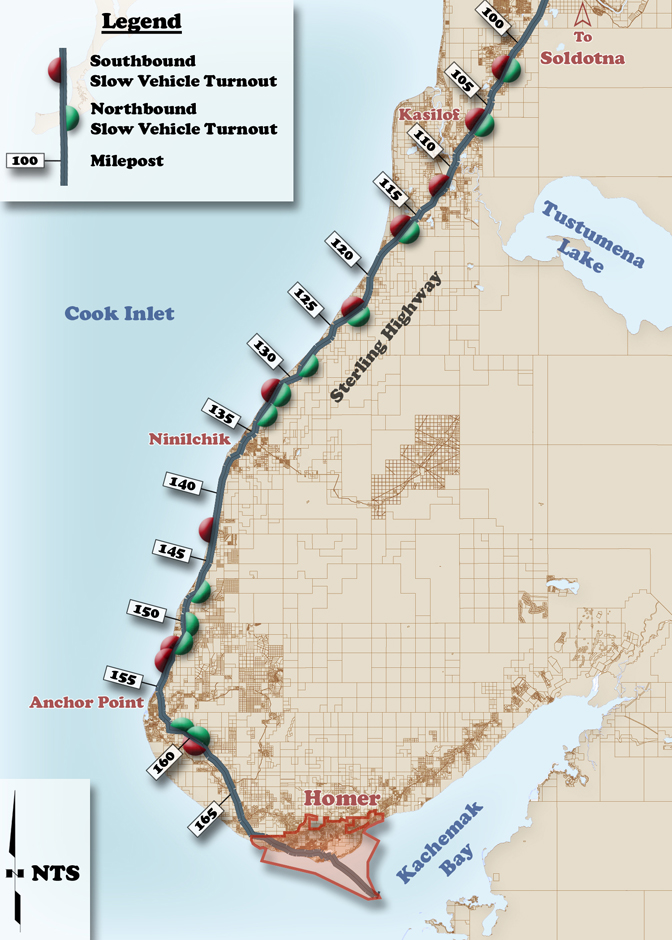Noting problem areas on the Sterling Highway between Soldotna and Homer — sites where vehicle accidents have occurred — the Alaska Department of Transportation and Public Facilities is planning slow-vehicle turnouts to help eliminate the problem.
The 12 northbound and 10 southbound pullouts considered for construction between milepost 100 and 165 were addressed at open houses at Homer Middle School on Tuesday and at Ninilchik School on Wednesday.
“Basically, we try to locate them where there seem to be accident locations we hope will be correctable by these,” said Kevin Jackson, DOT&PF project manager.
Between 2004 and 2008, 613 vehicle crashes were reported on the Sterling Highway between Soldotna and the top of the Homer hill. These accidents accounted for six fatalities and 185 injuries or possible injuries.
“We also try to locate the turnouts everywhere we could,” said Jackson.
“We were limited where we could put them.”
That, as it turned out, was no small thing for this stretch of the highway where turns and hills are frequent. It also explains why in some locations, such as the southbound lane between mile 150 and 156 and the northbound lane near mile 160, the turnouts are positioned so close together.
“It’s preferable to space them out evenly, but we can’t,” said Jackson.
Only one of the sites appears to require obtaining an easement.
“It’s not that we need it to construct the turnout, but where we’ll construct the ditch and it catches the outside of an existing right of way,” said Jackson. “We’ll be contacting that property owner and trying to buy the easement for the back-slope of our ditch.”
According to information provided by DOT&PF, daily traffic volumes in 2008 reached as high at 6,000 at the Soldotna end of this section of highway and 4,700 at the top of Homer hill, with 156-183 percent of the average daily traffic occurring in June, July and August. Summer peaks in the Anchor Point area have more than doubled the average daily traffic volumes.
“The mixture of lower speed ‘sightseeing,’ RV and boat-hauling drivers with the more aggressive weekend fishing-trip driver causes conflict and results in driver impatience, inattention, excessive speed proper passing, fatigue, etc.,” according to a DOT&PF report, which also notes that situation it “more complex” during summer months. In addition, the report points out that following slower driver and larger vehicles traveling at less uniform speeds “increases driver impatience and often results in increased reckless and aggressive driving fatigue. These are greater factors in head-on collisions than actual passing maneuvers.”
Since 1993, Alaska law has required drivers to pull over if they are causing a delay of five or more vehicles. In an effort to reduce head-on collisions throughout the state, DOT&PF and the Alaska Department of Public Safety have worked together on media education, enforcement and the construction of passing lanes and multi-lane highways. Rumble-strip centerlines and turnouts have been used in high crash areas. For portions of the highway lacking passing lanes, slow vehicle turnouts “are an affordable and more rapidly built interim measure with less design and construction impact,” said DOT&PF on its website.
But just how effective are turnouts in eliminating accidents?
“If people don’t use them, it won’t be effective, obviously, but right now there’s no place for people to turn out. As least we’ll be providing that,” said Jackson.
Costs for the project include:
• Design: $1,300,000
• Right-of-way: $20,000
• Construction: $7,521,000
• Utilities: $124,000.
• TOTAL: $8,965,000
The Sterling Highway slow vehicle turnout project will be funded through the Highway Safety Improvement Program. Construction will be completed in 2014.
A third open-house will be held at Tustumena Elementary School in Kasilof today from 4-7 p.m. For more on the project, visit www.sterlinghwysvt.com.
McKibben Jackinsky can be reached at mckibben.jackinsky@homernews.com.


